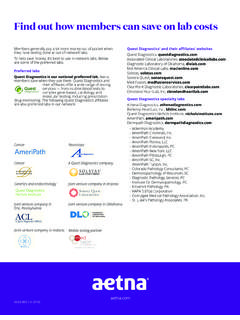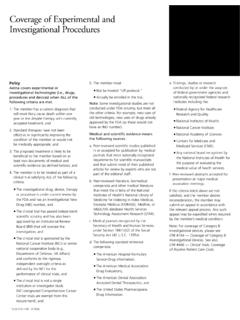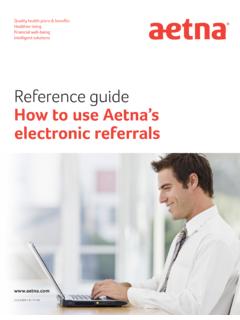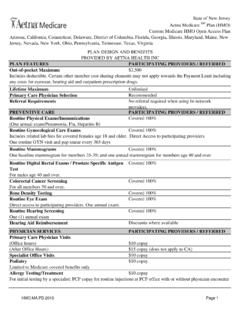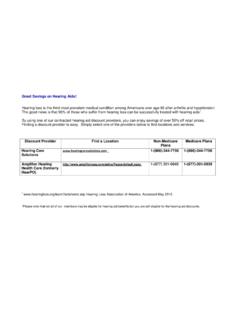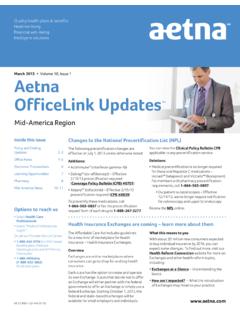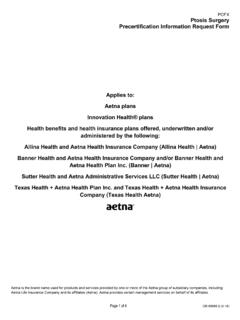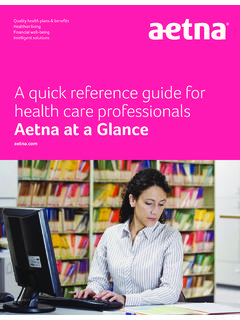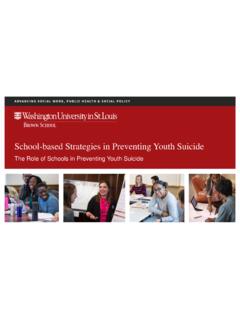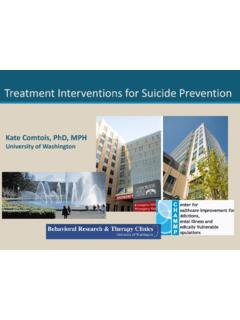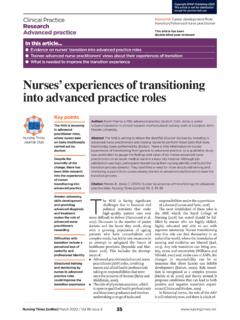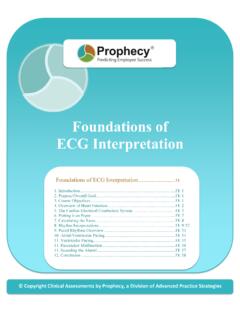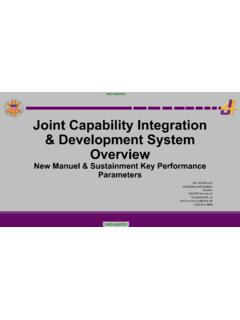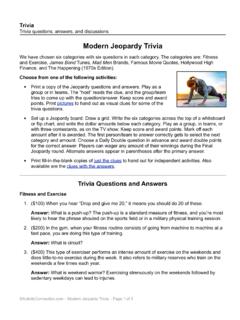Transcription of Dual Eligible Special Needs Plans (D-SNPs)
1 Dual Eligible Special Needs Plans (D-SNPs) Model of Care training and Attestation Proprietary and confidential; Not for further distribution without Aetna approval 2022 Aetna Inc. August 2021 CMS Requirements The Centers for Medicare & Medicaid Services (CMS) requires that all contracted medical providers and staff receive basic training about the Special Needs Plans (SNPs) Model of Care. This training and completion of an attestation are required for new providers.
2 And they must be completed yearly. The SNPs Model of Care is the plan for delivering coordinated care and care management to Special Needs members. This course will describe how we work together with our contracted providers to successfully deliver the SNPs Model of Care. 2022 Aetna Inc. Our Mission Our Special Needs Plan (SNP) program is designed to optimize the health and well being of our aging, vulnerable and chronically ill members. 2022 Aetna Inc. We re emerging as an industry leader in serving dual populations by: Developing best-in-class operating and clinical models Collaborating with members, providers and community organizations Pursuing quality solutions that address the full continuum of our members health care and social determinant Needs 2022 Aetna Inc.
3 Our Objectives Explain Dual Eligible Special Needs Plans (D-SNPs) Describe what D-SNPs offer Describe which dually Eligible individuals qualify for these Plans Describe our Model of Care and care plan management programs Describe how Medicare and Medicaid benefits are coordinated under the Plans Expand on the enhanced benefits of D-SNPs Complete your D-SNP Model of Care training Attestation to receive credit Explain how to get answers to your questions 2022 Aetna Inc. Who is Dual Eligible ? Medicare Eligibility Criteria Age 65 or older or Under 65 with a disability, such as Intellectual/developmental Cognitive Physical Behavioral health Needs Chronic medical conditions or Any age with End stage Renal Disease Medicaid Eligibility Criteria (ESRD) Meet income and asset requirements and Member of an Eligible group Adults with disabilities Older adults Children and families People who are pregnant Other 2022 Aetna Inc.
4 Two Types of Dually Eligible Full-benefit dually Eligible individuals: Qualify for Medicare Qualify for full state Medicaid benefits May receive financial assistance with Medicare premiums (and in many cases, cost sharing) Partial-benefit dually Eligible individuals: Qualify for Medicare Don t qualify for full Medicaid benefits premiums (and in many cases, cost sharing) May receive financial assistance with Medicare Cost sharing is a term used to describe a member's copayments, deductibles and coinsurance. 2022 Aetna Inc. Types of Assistance for Low-Income Medicare Beneficiaries Know the differences.
5 Low-Income Subsidy (LIS), aka Extra Help Part D LIS is a federally funded program that helps members pay for Part D prescription drugs Medicare Savings Programs (MSP) Parts A & B MSP is a federally funded program, administered by each state s Medicaid agency, that pays for things like Medicare copays, deductibles, premiums and coinsurance Medicaid Medicaid is a federal-state program run by each state that helps with health care costs and extra supplementary benefits All dual eligibles qualify for LIS. Not all LIS eligibles are dual- Eligible . 2022 Aetna Inc. Part D Extra Help, or Low-Income Subsidy (LIS) Program Dual members are Eligible to get full or partial help paying for prescription drugs.
6 This depends on what LIS level they fall into. Low-Income Subsidy helps pay for Part D: Premiums Deductibles Copayments Late enrollment penalties 2022 Aetna Inc. Medicare Savings Program (MSP) Federally-funded program Administered by each individual state s Medicaid agency For individuals with limited income and resources Medicaid helps to pay some or all Medicare premiums, deductibles, copayments and coinsurance Four MSP Categories: Note: There are also individuals who are dual Eligible who don t fall into one of these MSP categories called Full Benefit Dual Eligible (FBDE).
7 2022 Aetna Inc. MSP Levels and Medicaid Eligibility Categories (Full Medicaid Benefits) (Financial Support Only) QMB+ FBDE SLMB+ QMB SLMB QDWI QI *All SLMB+ and FBDE in Aetna Medicare 2022 DS NP Plans are cost share protected 2022 Aetna Inc. Cost Share Protection - What Does That Mean? Cost share: Cost share is a term used to describe a member s Medicare Parts A and B: Copayments Deductibles Coinsurance When we say that a member is cost share protected: We mean that the state Medicaid program pays the member s Medicare (Parts A and B) cost share on their behalf The member is not personally financially responsible for these costs and the provider can t balance bill the member QMB and QMB+ guidance.
8 Federal law forbids Medicare providers and suppliers, including pharmacies, from billing people in the QMB program for Medicare Parts A and B cost sharing 2022 Aetna Inc. What is a Special Needs Plan? A Special Needs Plan (SNP) is a Medicare Advantage (MA) Coordinated Care Plan (CCP). It is specifically designed to provide targeted care and limit enrollment to Special Needs individuals. A Special Needs individual could be any one of the following: An institutionalized individual A dual Eligible An individual with a severe or disabling chronic condition, as specified by CMS A SNP may be any type of MA CCP including: A local or regional preferred provider organization ( , LPPO or RPPO) plan A health maintenance organization (HMO) plan An HMO Point-of-Service (HMO-POS) plan SNP Type Membership Limited to.
9 Chronic Condition SNP (C-SNP) People who have specific chronic or disabling conditions such as Renal Disease (ESRD), HIV/AIDS, chronic heart failure or dementia) Institutional SNP (I-SNP) People who live in certain institutions (like a nursing home) or who require nursing care at home Dual Eligible SNP (D-SNP) People who are Eligible for both Medicare and Medicaid *We only offer D-SNPs 2022 Aetna Inc. CMS Requirements for Model of Care (MOC) Each DNSP state is required by CMS to submit a MOC document detailing the 4 areas below: Description of SNP Population Documentation of how the health plan will determine, verify and track eligibility Detailed profile of medical, social, cognitive, environmental conditions, etc.
10 Associated with SNP population Health conditions impacting beneficiaries & plan for especially vulnerable beneficiaries Care Coordination SNP staff structure, roles and training defined HRA tool description and plan for analyzing results ICP development process, beneficiary goals & health preferences Interdisciplinary Care Team (ICT) composition, member selection, health care outcomes evaluation Care transition protocols SNP Provider Network Specialized expertise available to SNP beneficiaries & how health plan evaluates competency of network Use of clinical practice guidelines & care transition protocols by providers MOC training for provider network Quality Measurement & Performance Improvement MOC Quality Performance Improvement Plan-process to collect and analyze data Measurable goals & health outcomes for the MOC Measure patient experience of care survey and analyze integrated results Ongoing performance improvement evaluation Disseminate
